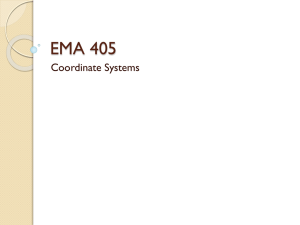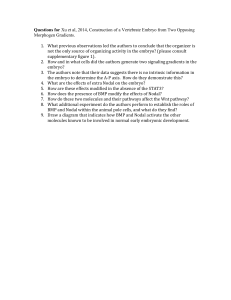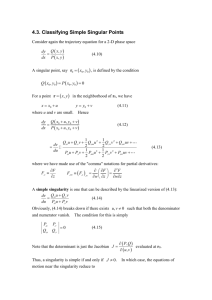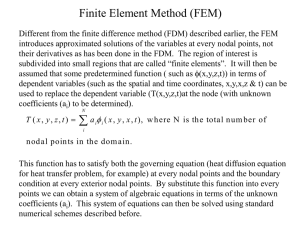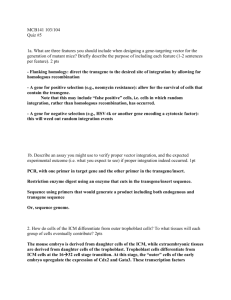ON NODAL LINES OF NEUMANN EIGENFUNCTIONS
advertisement
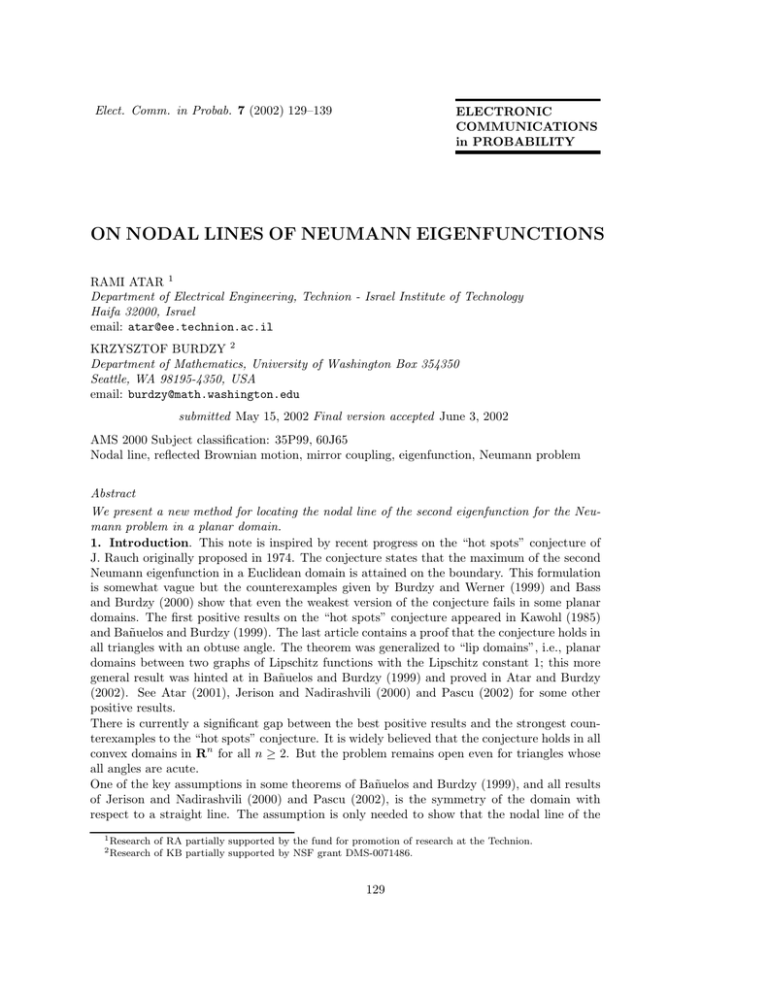
Elect. Comm. in Probab. 7 (2002) 129–139
ELECTRONIC
COMMUNICATIONS
in PROBABILITY
ON NODAL LINES OF NEUMANN EIGENFUNCTIONS
RAMI ATAR 1
Department of Electrical Engineering, Technion - Israel Institute of Technology
Haifa 32000, Israel
email: atar@ee.technion.ac.il
KRZYSZTOF BURDZY 2
Department of Mathematics, University of Washington Box 354350
Seattle, WA 98195-4350, USA
email: burdzy@math.washington.edu
submitted May 15, 2002 Final version accepted June 3, 2002
AMS 2000 Subject classification: 35P99, 60J65
Nodal line, reflected Brownian motion, mirror coupling, eigenfunction, Neumann problem
Abstract
We present a new method for locating the nodal line of the second eigenfunction for the Neumann problem in a planar domain.
1. Introduction. This note is inspired by recent progress on the “hot spots” conjecture of
J. Rauch originally proposed in 1974. The conjecture states that the maximum of the second
Neumann eigenfunction in a Euclidean domain is attained on the boundary. This formulation
is somewhat vague but the counterexamples given by Burdzy and Werner (1999) and Bass
and Burdzy (2000) show that even the weakest version of the conjecture fails in some planar
domains. The first positive results on the “hot spots” conjecture appeared in Kawohl (1985)
and Bañuelos and Burdzy (1999). The last article contains a proof that the conjecture holds in
all triangles with an obtuse angle. The theorem was generalized to “lip domains”, i.e., planar
domains between two graphs of Lipschitz functions with the Lipschitz constant 1; this more
general result was hinted at in Bañuelos and Burdzy (1999) and proved in Atar and Burdzy
(2002). See Atar (2001), Jerison and Nadirashvili (2000) and Pascu (2002) for some other
positive results.
There is currently a significant gap between the best positive results and the strongest counterexamples to the “hot spots” conjecture. It is widely believed that the conjecture holds in all
convex domains in Rn for all n ≥ 2. But the problem remains open even for triangles whose
all angles are acute.
One of the key assumptions in some theorems of Bañuelos and Burdzy (1999), and all results
of Jerison and Nadirashvili (2000) and Pascu (2002), is the symmetry of the domain with
respect to a straight line. The assumption is only needed to show that the nodal line of the
1 Research
2 Research
of RA partially supported by the fund for promotion of research at the Technion.
of KB partially supported by NSF grant DMS-0071486.
129
130
Electronic Communications in Probability
second Neumann eigenfunction lies on the line of symmetry. Then one can replace the original
Neumann problem on the whole domain with the mixed Dirichlet-Neumann problem on a
nodal subdomain. As it often happens in analysis, the Dirichlet problem (in this case, the
mixed Dirichlet-Neumann problem) turns out to be considerably easier to deal with than the
original Neumann problem. Hence, one would like to be able to find the location of the nodal
line for the second Neumann eigenfunction in domains which are not necessarily symmetric.
If this goal is achieved, some further progress on the “hot spots” conjecture may be expected.
Nodal lines also seem to be of interest of their own; see, for example, a paper of Melas (1992)
on the nodal lines in the Dirichlet case.
Very few methods for finding the nodal line are known; the following short list is probably
complete.
(a) If a domain has a line of symmetry, the nodal line lies on that line, subject to some
natural extra assumptions.
(b) There are a handful of classes of domains, such as rectangles and ellipses, for which
explicit formulae for eigenfunctions are known.
(c) One can find an approximate location of the nodal line in domains which are “long and
thin” in the asymptotic sense; see Jerison (2000).
The purpose of this note is to add the following item to this list.
(d) In some domains, one can use the probabilistic method of “couplings” to delineate a
region which the nodal line must intersect.
It should be emphasized that one cannot expect to find the location of the nodal line of the
second Neumann eigenfunction in the sense of an explicit formula, except in some trivial cases.
What one can realistically hope to achieve is to obtain sufficiently accurate information about
the nodal line so that this information can in turn be used to prove some other results of
interest; the combination of Lemmas 2 and 3 of Burdzy and Werner (1999) is an example of
such a result on nodal lines.
We are grateful to the referee for many useful suggestions.
2. Couplings and nodal lines. Suppose that D is a planar domain (open and connected
set) with a piecewise smooth boundary, i.e., the boundary consists of finitely many C 2 parts,
and the uniform exterior sphere condition and the uniform interior cone condition are satisfied.
Under these assumptions on D, one can prove strong existence and pathwise uniqueness for
reflecting Brownian motion in D (see Lions and Sznitman (1984) or Bass, Burdzy and Chen
(2002) for the new developments and a historical review). A coupling is a pair of reflecting
Brownian motions Xt and Yt in D, defined on a common probability space.
Our first theorem is inspired by “mirror couplings.” Informally speaking, a mirror coupling
is a pair (Xt , Yt ) of reflecting Brownian motions in D, such that the line of symmetry Kt
between Xt and Yt does not change on any interval (s, u) such that Xt ∈
/ ∂D and Yt ∈
/ ∂D for
all t ∈ (s, u). A rigorous construction of the mirror coupling was given in Atar and Burdzy
(2002) although mirror couplings had been informally used in the past; see Atar and Burdzy
(2002) for a short review of the history of this concept. Although mirror couplings can be
used to prove theorems about nodal lines (by applying Theorem 2.1 below with Kt being the
NODAL LINES
131
mirror), we will not use them in this paper. A different coupling, presented below, seems to
be better suited to this problem.
Recall that the first eigenvalue for the Laplacian in D with Neumann boundary conditions is
equal to 0 and the corresponding eigenfunction is constant. The second eigenvalue need not be
simple but its multiplicity can be only 1 or 2 (Nadirashvili (1986, 1988)). The nodal set is the
set of points in D where the second eigenfunction vanishes. If D is not simply connected, the
nodal set need not be a connected curve. The nodal set of any second Neumann eigenfunction
divides the domain D into exactly two nodal domains (connected and open sets).
Let x, y be points and K be a straight line, and denote by A1 and A2 the two connected
componenets of R2 \ K. We say that x and y lie on the opposite sides of K, if either x ∈ A1
and y ∈ A2 , or x ∈ A2 and y ∈ A1 .
Theorem 2.1. Suppose that A ⊂ D is closed, x ∈ D\A, D1 is a connected component of D\A
which contains x, and y ∈ D \ D1 . Assume that there exists a coupling (Xt , Yt ) of reflecting
Brownian motions in D and a line-valued stochastic process Kt with the following properties.
For every t ≥ 0, Xt and Yt lie on the opposite sides of Kt . Moreover, (X0 , Y0 ) = (x, y) and
Kt ∩ D ⊂ A for all t ≥ 0 a.s. Then for any second Neumann eigenfunction in D, none if its
nodal domains can have a closure which is a subset of D \ A containing x.
Proof. Suppose that B is one of the nodal domains for a second eigenfunction and x ∈ B ⊂
D \ A. We will show that this assumption leads to a contradiction. Let C1 be a non-empty
open disc centered at a boundary point of B, but not on the boundary of D, so small that
B∗ = B ∪ C1 satisfies x ∈ B ∗ ⊂ D \ A, and there exists a non-empty open disc C2 ⊂ D \ B∗ .
Assume that y, Xt , Yt and Kt satisfy the assumptions of the theorem. Since the stationary
measure for Xt is the uniform distribution in D, Xt will hit C2 with probability one, and
so it will leave B∗ with probability 1. Recall that there are exactly two nodal domains—
/ B∗ } and
B is one of them; let B1 denote the other one. Let τX (B∗ ) = inf{t ≥ 0 : Xt ∈
/ B1 }. We will argue that τX (B∗ ) < τY (B1 ) a.s. Suppose otherwise.
τY (B1 ) = inf{t ≥ 0 : Yt ∈
By the continuity of t → Yt , YτY (B1 ) belongs to ∂B1 \ ∂D, and so YτY (B1 ) ∈ B ⊂ B ∗ . We
have assumed that τX (B∗ ) ≥ τY (B1 ), so XτY (B1 ) ∈ B ∗ . Since the points XτY (B1 ) and YτY (B1 )
belong to the connected set B ∗ , the line KτY (B1 ) must also intersect B ∗ . We have Kt ∩ D ⊂ A
for all t so A ∩ B ∗ 6= ∅, which is a contradiction. We conclude that τX (B∗ ) < τY (B1 ) a.s.
Let µ > 0 denote the second Neumann eigenvalue for D (recall that the first eigenvalue is
equal to 0). Then µ is the first eigenvalue for the mixed problem in the nodal domain B,
with the Neumann boundary conditions on ∂D and the Dirichlet boundary conditions on the
nodal line. The fact that B∗ is strictly larger than B easily implies that µ > µ∗ , where µ∗
is the analogous mixed eigenvalue for B∗ . Using the well known identification of Brownian
motion density with the heat equation solution, we obtain from Proposition 2.1 of Bañuelos
and Burdzy (1999) that
lim P (τY (B1 ) > t)eµt ∈ (0, ∞).
t→∞
Since τX (B∗ ) < τY (B1 ) a.s.,
lim P (τX (B∗ ) > t)eµt < ∞,
t→∞
and so µ∗ ≥ µ, but this contradicts the fact that µ > µ∗ . Our initial assumption that
x ∈ B ⊂ D \ A for some nodal domain B must be false.
132
Electronic Communications in Probability
As we said before, Theorem 2.1 can be applied to mirror couplings to yield some results on
nodal lines. We will now introduce a new coupling which gives stronger results than the mirror
coupling for some families of domains. First, we will define a family of domains.
Let β denote the mapping which assigns to each point in R2 its symmetric image about the
vertical axis. Let (e1 , e2 ) be the usual orthonormal basis for R2 and let U+ be the right half
plane, i.e., U+ = {x ∈ R2 : x · e1 ≥ 0}. We will denote the left half plane U− = βU+ . A
convex set C ⊂ R2 will be called a cone if αx ∈ C for any x ∈ C and α ≥ 0.
Recall that D is a planar piecewise smooth domain. We will define a family of domains
via conditions (A1)-(A4) below, chosen to satisfy the demands of the proof of Theorem 2.2.
Conditions (A3)-(A4) are the most important of the four conditions because they impose
considerable restrictions on the shape of D. Assume that D intersects the vertical axis. Let
D1 = D ∩ U+ ,
e = βD,
D
D2 = D ∩ U− ,
e 1 = βD1 ,
D
e 2 = βD2 .
D
For i = 1, 2, let ∂Di denote the set of all boundary points of Di , where the boundary is smooth,
e i be defined similarly. We will write n(x)
except those that lie on the vertical axis. Let ∂ D
for the inward normal to ∂Di at x ∈ ∂Di , for i = 1, 2. With an abuse of notation, the same
e i.
e i at x ∈ ∂ D
symbol n(x) will be used to denote the inward normal to ∂ D
e 2.
(A1) D1 ⊂ D
e except for a finite set of such x, the sets ∂D and ∂ D
e agree in some
(A2) For all x ∈ ∂D ∩ ∂ D
neighborhood of x.
e 2 , one has n(x) ∈ C.
(A3) There exists a closed cone C ⊂ U− such that for any x ∈ ∂D1 \ ∂ D
In the case when C is a proper subset of U− , let v1 and v2 denote the two unit vectors that
generate the cone C, i.e., all vectors in C are linear combinations of v1 and v2 with nonnegative coefficients. For i = 1, 2, let vi⊥ denote the unit vector orthogonal to vi , such that
vi⊥ · v3−i > 0. In the case when C = U− , let v1 = −e2 , v2 = e2 , and v1⊥ = v2⊥ = −e1 . Note
that in both cases,
(2.1)
vi + εvi⊥ ∈ C,
provided that ε > 0 is small enough.
For x ∈ R2 , let the ray through x be denoted as R(x) = {αx : α > 0}.
e 1 ∩ ∂D2 ) and i = 1, 2, if y + R(vi ) intersects D then n(x) · v ⊥ ≤ 0 for
e 2 ∪ (∂ D
(A4) (i) For y ∈ ∂ D
i
e 2 ) and i = 1, 2, if y − R(vi )
e 2 in a neighborhood of y. (ii) For y ∈ ∂D2 ∪ (∂D1 ∩ ∂ D
all x ∈ ∂ D
e then n(x) · v ⊥ ≥ 0 for all x ∈ ∂D2 in a neighborhood of y.
intersects D
i
Geometric conditions (A1)-(A4) (especially (A3)-(A4)) might not be easy to visualize. To help
the reader, we present an “extreme” domain satisfying all these conditions in Example 3.4 and
the corresponding Figure 4 in the next section. The example is our attempt to show the “most
irregular” or “unusual” shape for which (A1)-(A4) hold.
e and Wt is a planar Brownian motion. Then there exist a reflecting
Suppose that x ∈ D ∩ D
e driven by Wt , and
Brownian motion Xt in D, and a reflecting Brownian motion Yt in D,
starting from x:
Z t
Z t
n(Xs )dLs , Yt = x + Wt +
n(Ys )dMs .
(2.2)
Xt = x + Wt +
0
0
NODAL LINES
133
Here Lt and Mt are local times on the boundary for Xt and Yt ; see Lions and Sznitman (1984)
for more details on boundary local times.
Theorem 2.2. Assume that D satisfies conditions (A1)-(A4) and Xt and Yt satisfy (2.2).
Then with probability one, for all t ≥ 0, Xt − Yt ∈ C.
Proof: We have assumed that ∂D is smooth, except for a finite number of points—it is
well known that the set of these points is polar for the reflected Brownian motion in D. For
all x ∈ ∂D outside this set, n(x) is well defined and n(y) depends continuously on y ∈ ∂D
in a neighborhood of x. Assume that the assertion of the theorem does not hold, and let
σ = inf{t : Xt − Yt 6∈ C}. Clearly, Xσ − Yσ ∈ ∂C.
e then there is ε > 0 such that Xt ∈ D and Yt ∈ D
e for all t ∈ [σ, σ + ε].
If Xσ ∈ D and Yσ ∈ D,
By (2.2), Xt − Yt = Xσ − Yσ ∈ ∂C for all such t, contradicting the definition of σ. Hence
e
either Xσ ∈ ∂D or Yσ ∈ ∂ D.
e 1 . Since the cases are
If Xσ = Yσ , then using condition (A1), either Xσ ∈ ∂D1 or Yσ ∈ ∂ D
similar, we will discuss only the former. Consider the following two cases.
e then, by (A2), ∂D and ∂ D
e agree in a small neighborhood of Xσ . Using
(a) If Xσ ∈ ∂D ∩ ∂ D
(2.2) and strong uniqueness, we see that Xt = Yt for t ∈ [σ, σ + δ], if δ > 0 is sufficiently small.
This contradicts the definition of σ.
e 2 and Yσ ∈ D.
e Then for small ε > 0 and all
(b) The other case is when Xσ ∈ ∂D1 \ ∂ D
Rt
Rt
t ∈ [σ, σ + ε], Xt − Yt = σ n(Xs )dLs . Condition (A3) implies that σ n(Xs )dLs ∈ C for all
such t, provided that ε is small enough, contradicting the definition of σ.
We conclude that Xσ 6= Yσ and so Xσ − Yσ ∈ ∂C \ {0}. In other words,
Xσ − Yσ = αvi ,
(2.3)
where α > 0 and either i = 1 or i = 2.
The rest of the argument is split into three cases with subcases.
e
Case 1: Yσ ∈ D.
R
e 2 . In this case, Xt − Yt = αvi + t n(Xs )dLs for t ∈ [σ, σ + ε] provided
(a) Xσ ∈ ∂D1 \ ∂ D
σ
that ε > 0 is small enough. By condition (A3), Xt − Yt ∈ C for all such t, taking, if necessary,
ε > 0 smaller. This ontradicts the definition of σ.
e 2 ). This is similar to Case 2(a) considered below, except that we
(b) Xσ ∈ ∂D2 ∪ (∂D1 ∩ ∂ D
should use condition (A4)(ii) in place of (A4)(i).
e 2 ∪ (∂ D
e 1 ∩ ∂D2 ).
Case 2: Yσ ∈ ∂ D
A single argument will apply to subcases (a) and (b):
(a) Xσ ∈ D.
e 2.
(b) Xσ ∈ ∂D1 \ ∂ D
In either case we have
Z t
Z t
n(Xs )dLs −
n(Ys )dMs .
Xt − Yt = αvi +
σ
(2.4)
σ
Since Xσ ∈ D, (2.3) implies that Yσ + R(vi ) intersects D. Hence, by condition (A4)(i),
Rt
n(Ys )dMs · vi⊥ ≤ 0 for t ∈ [σ, σ + ε], provided ε > 0 is small. As before, condition (A3)
σ
134
Electronic Communications in Probability
Rt
implies that σ n(Xs )dLs ∈ C. As a result, using (2.1), Xt − Yt ∈ C for t ∈ [σ, σ + ε] if ε > 0
is small enough. This contradicts the definition of σ.
e 2 ). In this case (2.4) again holds, and using condition (A4)(i),
(c) Xσ ∈ ∂D2 ∪ (∂D1 ∩ ∂ D
Rt
Rt
⊥
⊥
σ n(Ys )dMs · vi ≤ 0. Moreover, by condition (A4)(ii), σ n(Xs )dLs · vi ≥ 0. An application
of (2.1) again shows that Xt − Yt ∈ C for t ∈ [σ, σ + ε] and ε > 0 small. This is impossible, in
view of the definition of σ.
e 1 \ ∂D2 .
Case 3: Yσ ∈ ∂ D
e 1 \ ∂D2 , n(y) ∈ −C. Hence this
(a) Xσ ∈ D. Note that condition (A3) implies that for y ∈ ∂ D
Rt
case is similar to Case 1(a), with the difference that now we have Xt − Yt = αvi − σ n(Ys )dMs
for t ∈ [σ, σ + ε].
e 2 . Since ∂ D
e 1 + C does not intersect ∂D1 , this case is ruled out by (2.3).
(b) X ∈ ∂D1 \ ∂ D
e 2 ). This case is similar to Case 2(b) considered above.
(c) Xσ ∈ ∂D2 ∪ (∂D1 ∩ ∂ D
We arrived at a contradiction in all cases. As a result, Xt − Yt ∈ C must hold for all t ≥ 0,
with probability one.
Recall that e1 is the first base vector of R2 . Under the assumptions of Theorem 2.2 we have
e1 · (Xt − Yt ) ≤ 0 for all t. Let Ye = βY and note that Xt and Yet are reflecting Brownian
motions in D. Then e1 · (Xt + Yet ) ≤ 0 for all t. This implies that if Kt denotes the vertical line
passing through the midpoint of Xt and Yet then Kt ⊂ U− for all t ≥ 0. This and Theorem
2.1, applied with A = U− ∩ D, yield the following.
Corollary 2.3. Assume that D satisfies conditions (A1)-(A4). Then for any second Neumann
eigenfunction in D, its nodal line must intersect D2 .
3. Examples. We will present two examples illustrating Corollary 2.3. Then we will indicate
how Theorem 2.1 can be combined with mirror couplings. But first we would like to point out
that in the one-dimensional case, i.e., in the case when D is a line segment, one can use the
“mirror” coupling of Brownian motions reflected at the endpoints of D to prove that the nodal
point lies in the middle of D—we leave the details of the proof as an elementary excercise for
the reader.
Example 3.1. Suppose that D is an obtuse triangle with vertices C1 , C2 and C3 . Let C3 be the
vertex with an angle greater than π/2, and suppose that the angle at C2 is not smaller than that
at C1 (see Figure 1). Let Cj Ck denote the line segment with endpoints Cj and Ck . The points
Ck , k = 4, . . . , 10, are chosen so that C5 , C10 ∈ C1 C3 , C8 ∈ C2 C3 , C9 , C6 , C4 , C7 ∈ C1 C2 , and
the following pairs of line segments are perpendicular: C1 C2 and C3 C4 , C1 C2 and C5 C6 , C2 C3
and C5 C9 , C2 C3 and C4 C8 , C1 C3 and C7 C3 , C1 C3 and C6 C10 . The point C6 lies half way
between C1 and C4 .
NODAL LINES
135
C
3
C
10
C
1
C
9
C
8
C
5
C
4
C
6
C
7
C
2
Figure 1.
Let A be the closed subset of D (trapezoid) with vertices C3 , C4 , C6 and C5 . Let A1 be the
closure of the union of the quadrilateral with vertices C3 C7 C9 C5 and pentagon C3 C8 C4 C6 C10 .
The second Neumann eigenvalue is simple in obtuse triangles by a theorem of Atar and Burdzy
(2002).
We will show that
(i) The nodal line for the second Neumann eigenfunction must intersect A.
(ii) The nodal line lies within A1 .
First, place the coordinate system so that the vertical axis passes through C3 C4 . Then let v1
be the vector perpendicular to C2 C3 , pointing to the left, and let v2 be its image under the
map (x1 , x2 ) 7→ (x1 , −x2 ). It is then elementary to check that the assumptions (A1)-(A4) of
Theorem 2.2 are satisfied and so Corollary 2.3 applies. We conclude that the nodal line must
intersect the closed triangle C1 C4 C3 .
Next place the coordinate system in such a way that C5 C6 lies on the vertical axis. Then flip
the triangle around the vertical axis, i.e., apply the transformation we call β. We will apply
Theorem 2.2 and Corollary 2.3 to this new triangle. In this case we take C = U− . Again, it
is completely routine to check that (A1)-(A4) are satisfied. We conclude that the nodal line
must cross the closed quadrilateral C6 C2 C3 C5 . This completes the proof of (i).
Claim (ii) is a consequence of (i) and the bounds on the direction of the gradient of the second
eigenfunction proved in Theorem 3.1 of Bañuelos and Burdzy (1999).
Remark. We will argue heuristically that it is impossible to obtain much sharper estimates
for the nodal line location. It is not hard to show that if the triangle is isosceles then the
nodal line is the line of symmetry. This shows that C3 C4 is a sharp “bound”. To see how
sharp is the other “bound”, i.e., C5 C6 , consider an obtuse triangle with two angles very close
to π/2—one slightly less than the right angle and another one slightly larger than that (see
Figure 2). Such a triangle has a shape very close to a thin circular sector. Let us assume that
the diameter of the triangle is equal to 1. The nodal line in a circular sector is an arc with
center at its vertex A. The nodal line distance from A is equal to a0 /a1 ≈ 0.63, where a0 is
the first positive zero of the Bessel function of order 0 and a1 is the first positive zero of its
136
Electronic Communications in Probability
derivative. This follows from known results on eigenfunctions in discs and estimates for Bessel
function zeroes, see Bandle (1980), p. 92. Our methods yield 0.5 as the lower bound for the
distance of the nodal line from A; we see that this estimate cannot be improved beyond 0.63.
A
0
0.63
1
Figure 2.
We end this example with a conjecture.
Conjecture 3.2. The nodal line for the second Neumann eigenfunction is contained in the
triangle C1 C3 C4 .
Little is known about eigenfunctions in triangles different from equilateral; see Pinsky (1980,
1985) for that special case.
Example 3.3. Consider a domain D in the plane whose boundary contains line segments
{(x1 , x2 ) : −a ≤ x1 ≤ a, x2 = 0} and {(x1 , x2 ) : −a ≤ x1 ≤ a, x2 = 1} for some a > 0. Suppose
that the remaining parts of ∂D are contained in {(x1 , x2 ) : −a − b ≤ x1 ≤ −a, 0 ≤ x2 ≤ 1}
and {(x1 , x2 ) : a ≤ x1 ≤ a + b, 0 ≤ x2 ≤ 1}, and moreover, they are graphs of functions in the
coordinate system with the basis (e2 , −e1 ), i.e., the usual coordinate system rotated by the
angle π/2. Let
A = {(x1 , x2 ) ∈ D : −b/2 ≤ x1 ≤ b/2},
A1 = {(x1 , x2 ) ∈ D : −b/2 − 1 ≤ x1 ≤ b/2 + 1}.
Figure 3 shows an example of D and the corresponding rectangle A.
Figure 3.
We will prove that
(i) The nodal line for any second Neumann eigenfunction must intersect A.
We call a set D a “lip domain” if its boundary consists of graphs of two Lipschitz functions
with the Lipschitz constant 1. The second eigenvalue is simple in every lip domain, by a result
of Atar and Burdzy (2002).
Our second claim is
NODAL LINES
137
(ii) If D is a lip domain then the nodal line for the Neumann eigenfunction lies within A1 .
Place the coordinate system so that the right vertical edge of the boundary of A lies on the
vertical axis. Let the cone C be equal to U− . Then conditions (A1)-(A4) of Theorem 2.2 and
Corollary 2.3 are easily verified and it follows that the nodal line has to intersect the set to the
left of the right edge of A. A similar argument applies to the left edge of A and this completes
the proof of (i).
The second claim follows from the first one and the bounds on the direction of the gradient of
the second eigenfunction in lip domains given in Example 3.1 of Bañuelos and Burdzy (1999).
e are depicted in Figure 4. If we take
Example 3.4. A domain D and its mirror image D
C = U− then Corollary 2.3 can be used to show that the nodal line intersects the part of D
to the left of the dotted vertical line.
Figure 4. The thick line is the boundary of D.
We end the article with a challenge for the reader to use mirror couplings in conjuction with
Theorem 2.1. Such couplings have been applied to study Neumann eigenfunctions in several
papers (see, e.g., Atar and Burdzy (2002) or Bañuelos and Burdzy (1999)) so we felt that it
would be more exciting to present here examples based on different couplings, described in
Theorem 2.2.
We will recall a few crucial facts about mirror couplings from Burdzy and Kendall (2000) and
Bañuelos and Burdzy (1999). Suppose that D is a polygonal domain and I is a line segment
contained in its boundary. Let J denote the straight line containing I and recall that Kt
denotes the mirror line. Let Ht denote the “hinge,” i.e., the intersection of Kt and J. Note
that Ht need not belong to ∂D. Suppose that for all t in [t1 , t2 ], the reflected Brownian motions
Xt and Yt do not reflect from any part of ∂D except I. Let αt denote the smaller of the two
angles formed by Kt and J. Then all possible movements of Kt have to satisfy the following
condition.
(M) The hinge does not move within the time interval [t1 , t2 ], i.e., Ht = Ht1 for all t ∈ [t1 , t2 ].
The angle αt is a non-decreasing function of t on [t1 , t2 ].
A domain D with piecewise smooth boundary can be approximated by polynomial domains
Dn . Mirror couplings in the approximating domains Dn converge weakly to a mirror coupling
138
Electronic Communications in Probability
in D. One can deduce which motions of the mirror Kt in D are possible by analyzing all
allowed movements of mirrors in Dn ’s and then passing to the limit.
Excercise 3.5. Use mirror couplings to show that in Example 3.1, the nodal line has to
intersect the subset of D which lies to the right of the arc passing through C5 and centered at
C1 .
Exercise 3.5 was originally a part of a theorem. We deleted the proof to keep the article short.
NODAL LINES
139
REFERENCES
[1] R. Atar (2001). Invariant wedges for a two-point reflecting Brownian motion and the
“hot spots” problem. Elect. J. of Probab. 6, paper 18, 1–19.
[2] R. Atar and K. Burdzy (2002), On Neumann eigenfunctions in lip domains (preprint).
[3] C. Bandle Isoperimetric Inequalities and Applications. Monographs and Studies in Mathematics, 7. Pitman, Boston, Mass.-London, 1980.
[4] R. Bañuelos and K. Burdzy (1999), On the “hot spots” conjecture of J. Rauch. J. Func.
Anal. 164, 1–33.
[5] R. Bass and K. Burdzy (2000) Fiber Brownian motion and the ‘hot spots’ problem Duke
Math. J. 105, 25–58.
[6] R. Bass, K. Burdzy and Z.-Q. Chen (2002) Uniqueness for reflecting Brownian motion
in lip domains (preprint).
[7] K. Burdzy and W. Kendall (2000) Efficient Markovian couplings: examples and counterexamples Ann. Appl. Probab. 10, 362-409.
[8] K. Burdzy and W. Werner (1999) A counterexample to the ”hot spots” conjecture. Ann.
Math. 149, 309–317.
[9] D. Jerison (2000) Locating the first nodal line in the Neumann problem. Trans. Amer.
Math. Soc. 352, 2301-2317.
[10] D. Jerison and N. Nadirashvili (2000) The “hot spots” conjecture for domains with two
axes of symmetry. J. Amer. Math. Soc. 13, 741–772.
[11] B. Kawohl, Rearrangements and Convexity of Level Sets in PDE, Lecture Notes in Mathematics 1150, Springer, Berlin, 1985.
[12] P.-L. Lions and A.-S. Sznitman, Stochastic differential equations with reflecting
boundary conditions. Comm. Pure Appl. Math. 37 (1984), 511–537.
[13] A. Melas (1992) On the nodal line of the second eigenfunction of the Laplacian in R2 .
J. Differential Geom. 35, 255–263.
[14] N.S. Nadirashvili (1986) On the multiplicity of the eigenvalues of the Neumann problem,
Soviet Mathematics, Doklady, 33, 281–282.
[15] N.S. Nadirashvili (1988) Multiple eigenvalues of the Laplace operator, Mathematics of
the USSR, Sbornik, 133-134, 225–238.
[16] M. Pascu (2002) Scaling coupling of reflecting Brownian motions and the hot spots
problem Trans. Amer. Math. Soc. (to appear)
[17] M. Pinsky (1980) The eigenvalues of an equilateral triangle. SIAM J. Math. Anal. 11,
819–827.
[18] M. Pinsky (1985) Completeness of the eigenfunctions of the equilateral triangle. SIAM
J. Math. Anal. 16, 848–851.
